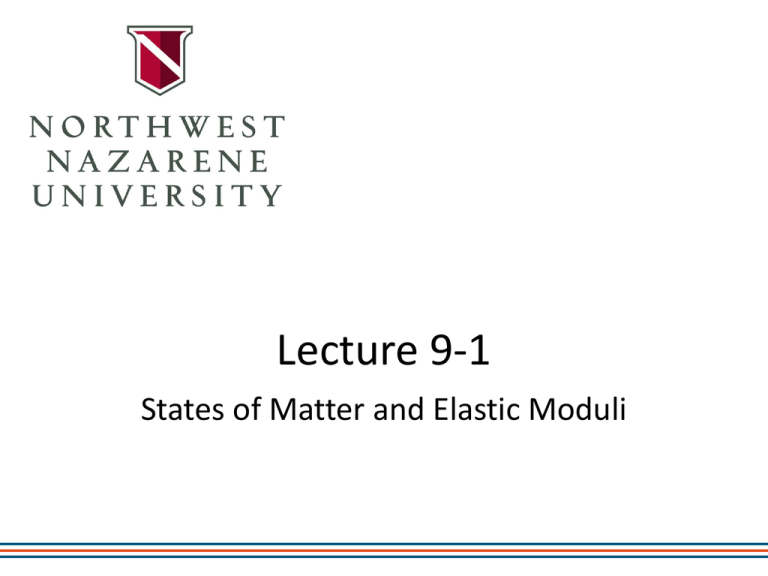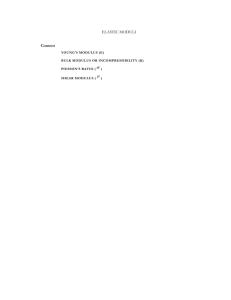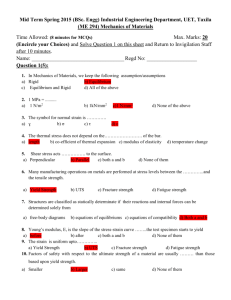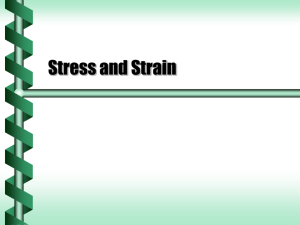elastic modulus
advertisement

Lecture 9-1 States of Matter and Elastic Moduli States of Matter • Solid, liquid, gas – Predominate on Earth • Plasma – Predominates in the universe • This chapter introduces basic properties of solids and liquids – Includes some properties of gases Introduction Solids • Has definite volume • Has definite shape • Molecules are held in specific locations – by electrical forces • vibrate about equilibrium positions • Can be modeled as springs connecting molecules More About Solids • External forces can be applied to the solid and compress the material – In the model, the springs would be compressed • When the force is removed, the solid returns to its original shape and size – This property is called elasticity Section 9.1 Crystalline Solid • Atoms have an ordered structure • This example is salt – Gray spheres represent Na+ ions – Green spheres represent Cl- ions Section 9.1 Amorphous Solid • Atoms are arranged almost randomly • Examples include glass Section 9.1 Liquid • Has a definite volume • No definite shape • Exists at a higher temperature than solids • The molecules “wander” through the liquid in a random fashion – The intermolecular forces are not strong enough to keep the molecules in a fixed position Section 9.1 Gas • • • • Has no definite volume Has no definite shape Molecules are in constant random motion The molecules exert only weak forces on each other • Average distance between molecules is large compared to the size of the molecules Section 9.1 Plasma • Gas heated to a very high temperature • Many of the electrons are freed from the nucleus • Result is a collection of free, electrically charged ions • Long-range electrical and magnetic forces allow interactions within the plasma • Plasmas exist inside stars Section 9.1 Types of Matter • Normal matter – About 5% of total matter • Dark matter – Affects the motion of stars in galaxies – May be as much as 25% of total matter • Dark energy – Accounts for acceleration of the expansion of the universe – May be as much as 70% of all matter Section 9.1 Deformation of Solids • All objects are deformable • It is possible to change the shape or size (or both) of an object through the application of external forces • When the forces are removed, the object tends to its original shape – An object undergoing this type of deformation exhibits elastic behavior Section 9.3 Elastic Properties • Stress is the force per unit area causing the deformation • Strain is a measure of the amount of deformation • The elastic modulus is the constant of proportionality between stress and strain – For sufficiently small stresses, the stress is directly proportional to the strain – The constant of proportionality depends on the material being deformed and the nature of the deformation Section 9.3 Elastic Modulus • stress = elastic modulus x strain • The elastic modulus can be thought of as the stiffness of the material – A material with a large elastic modulus is very stiff and difficult to deform • Analogous to the spring constant Section 9.3 Young’s Modulus: Elasticity in Length • The bar is stressed – Its length is greater than Lo – The external force is balanced by internal forces • Tensile stress is the ratio of the external force to the cross-sectional area – Tensile is because the bar is under tension Section 9.3 Young’s Modulus, cont. • SI unit of stress is Pascal, Pa – 1 Pa = 1 N/m2 • The tensile strain is the ratio of the change in length to the original length – Strain is dimensionless • The elastic modulus is called Young’s modulus Section 9.3 Young’s Modulus, final • Young’s modulus applies to a stress of either tension or compression • Experiments show: – The change in length for a fixed external force is proportional to the original length – The force necessary to produce a given strain is proportional to the cross-sectional area Section 9.3 Elastic Behavior Graph • It is possible to exceed the elastic limit of the material – No longer directly proportional – Ordinarily does not return to its original length • If stress continues, it surpasses its ultimate strength – The ultimate strength is the greatest stress the object can withstand without breaking Section 9.3 Modulus Table Breaking • The breaking point – For a brittle material, the breaking point is just beyond its ultimate strength – For a ductile material, after passing the ultimate strength the material thins and stretches at a lower stress level before breaking Section 9.3 Ultimate Strength of Materials • The ultimate strength of a material is the maximum force per unit area the material can withstand before it breaks or factures • Some materials are stronger in compression than in tension Section 9.3 Ultimate Strength Table A vertical steel beam in a building supports a load of 6.0 × 104 N. If the length of the beam is 4.0 m and its cross-sectional area 8.0 × 10-3 m2, find the distance the beam is compressed along its length. What is the maximum load in newtons could the steel beam support before failing? A vertical steel beam in a building supports a load of 6.0 × 104 N. If the length of the beam is 4.0 m and its cross-sectional area 8.0 × 10-3 m2, find the distance the beam is compressed along its length. What is the maximum load in newtons could the steel beam support before failing? Shear Modulus: Elasticity of Shape • Forces may be parallel to one of the object’s faces • The stress is called a shear stress – Defined as the ratio of the magnitude of the parallel force to the area of the face being sheared • The shear strain is the ratio of the horizontal displacement and the height of the object • The shear modulus is S Section 9.3 Shear Modulus, Equations • • S is the shear modulus • A material having a large shear modulus is difficult to bend Section 9.3 Shear Modulus, final • There is no volume change in this type of deformation • Remember the force is parallel to the crosssectional area – In tensile stress, the force is perpendicular to the cross-sectional area Section 9.3 A defensive lineman of mass M = 125 kg makes a flying tackle at Vi=4.00m/s on a stationary quarterback of mass m =85.0 kg, and the lineman’s helmet makes solid contact with the quarterback’s femur. (a) What is the speed vf of the two athletes immediately after contact? Assume a linear inelastic collision. (b) If the collision lasts for 0.100s Estimate the average force exerted on the quarterback’s femur. (c) If the cross-sectional area of the quarterback’s femur is 5.00 x10-4 m2, calculate the shear stress exerted on the bone in the collision. Bulk Modulus: Volume Elasticity • Bulk modulus characterizes the response of an object to uniform squeezing – Suppose the forces are perpendicular to, and act on, all the surfaces • Example: when an object is immersed in a fluid • The object undergoes a change in volume without a change in shape Section 9.3 Bulk Modulus, cont. • Volume stress, ΔP, is the ratio of the change in the magnitude of the applied force to the surface area – This is also a change in pressure • The volume strain is equal to the ratio of the change in volume to the original volume Section 9.3 Bulk Modulus, final • A material with a large bulk modulus is difficult to compress • The negative sign is included since an increase in pressure will produce a decrease in volume – B is always positive • The compressibility is the reciprocal of the bulk modulus Section 9.3 A solid lead sphere of volume 0.50 m3, dropped in the ocean, sinks to a depth of 2.0 × 103 m (about 1 mile) where the pressure increases by 2.0 × 107 Pa. Lead has a bulk modulus of 4.2 × 1010 Pa. What is the change in volume of the sphere? Notes on Moduli • Solids have Young’s, Bulk, and Shear moduli • Liquids have only bulk moduli, they will not undergo a shearing or tensile stress – The liquid would flow instead Section 9.3









